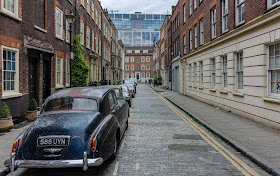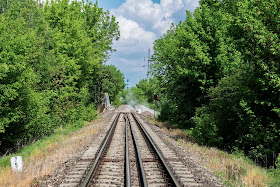Friday in the City and the chance to explore; I am often visiting the City on business and rather than head back to Ealing from the nearest Tube station, I meander westwards on foot, each time choosing a new route. There is so much to see, so much to discover, and such a rich history that is visually and intellectually rewarding.
Below: peak Spitalfields, hipster capital of London, where old brick has been put to new use. A once run-down area within walking distance of the skyscrapers of the City's financial heart has become a Most sought-after location.
Right: here we are, right at the edge. In the background and to the right, the steel and glass of a modern financial hub; the NatWest and RBS buildings on Bishopsgate. In front of them and to the left, the early Victorian brick and cobbles of Spital Yard. The 'Spital' comes from St Mary's Hospital, founded in 1197.
The district was associated with weaving, cloth-making and garment manufacture with successive waves of immigrants since the 17th century - Huguenots, Jews and Bangladeshis - establishing themselves and their businesses around here.
The gatehouse to St Bartholomew-the-Great church. There are two parishes side by side; St Bartholomew-the-Great and St Bartholomew-the-Less, formerly the parish church of Bartholomew's Hospital, ('Barts'), the teaching hospital, founded by the Augustinian Friars in 1123. The entire complex stands between Smithfield Market to the north, the Old Bailey (Central Criminal Court) to the south-west and the Bank of England to the south-east.
London's rich mediaeval history was mostly destroyed in the Great Fire of 1666 but St Barts survived.
Right: the word 'bedlam' comes from the corruption of the word Bethlehem, which by 1460 had become Europe's first psychiatric hospital. This plaque is to be found by the Liverpool Street entrance to Liverpool Street station.
The words 'hospital', 'hostel' and 'hotel' derive their etymology from the same route (the dropped 's' replaced by the circumflex over the 'o' as in the French spelling of
hôtel. Originally, "hostels of God," early mediaeval hospitals provided hospitality to guests - pilgrims - and patients alike. Only after the Dissolution of the Monasteries by Henry VIII in the late 1530s did the roles of hospital and pilgrim's rest begin to diverge.
Left: the entrance to the Museum of the Order of St John - the Knights Hospitaller, located in Clerkenwell in the old priory gatehouse, built in 1504. The museum tells the story of how the monastic order was founded in the 11th century during the First Crusade in Jerusalem to look after Christian pilgrims travelling to the Holy Land - and how it subsequently turned into what is now St John Ambulance Brigade. The brigade's logo - the Maltese Cross - seen on the pavement - shows the continuity of the organisation spanning almost one millennium.
Left: Lowndes House, No.1 City Road. Built in 1929 in an imperial style that would already have appeared dated at that time when modernism was the rage, this was the London headquarters of the Singer Sewing Machine Company. Singer's UK manufacturing facility was in Glasgow. Compared to other Singer buildings - such as the one in St Petersburg - quite modest. Singer was one of the first American multinational corporations, with a global reach well before WW1. Today, the Grade II listed building serves as a Travelodge hotel.
Below: O joy! I walked the length of Spitalfields' Elder Street, expecting that a good street landscape would be spoilt by modern cars. But no! A Bentley S1, built between 1955 and '59. And how perfectly placed, at the end of the street...
...standing next to a Morris Minor Series II convertible (1952-56)! A marvellous sight! Both displaying the patina of decades of driving.
Below: onwards from Spitalfields to Smithfields - and another classic, somewhat younger (late 1970s, so only 40 years old) MG MGB Roadster passes the meat market.
Left: at Smithfields, to find the house in which lived Sir John Betjeman. It's here - at 43 Cloth Fair, the entrance being on Cloth Court. This was his London home from 1954 to 1972, with an interlude (1958-59) living at Rotherhithe while the flat was being refurbished following a fire. A fine location from which to explore the City, Those 18 years saw many historic buildings making way for steel-and-glass offices.
Right: blue plaque over the door to Sir John Betjeman's flat. His youthful explorations of the City of London were described in Chapter VI, his autobiographical poem,
Summoned by Bells; he would visit the City's churches on Sundays, drawn towards the more obscure ones.
Below: Christ Church, Spitalfields, a
Hawksmoor design. It was one of a spate of churches erected as a result of the work of the
Commission for Building Fifty New Churches. Not 50 but 12 arose in and around London in the first half of the 18th century; this one in particular to minister to Huguenots who had fled France to England to avoid religious persecution at home. To the left of frame in this photo, Spitalfields Market. Street food and street fashions.
By the 19th century, the mission of Christ Church had changed with the coming of a new influx of immigrants - Jewish refugees from the Russian
Pale of Settlement. The
London Society for Promoting Christianity Amongst the Jews was active in this parish, as can be seen in many of the plaques inside the vestibule, commemorating Jews who had converted and those who ministered to them (
below).
Left: another literary 'JB' - John Bunyan, author of
Pilgrim's Progress. Here is his grave, at the Bunhill Fields Burial Ground. As with the works of John Betjeman, I was introduced to
Pilgrim's Progress at school. All I can remember of Bunyan's book are the words 'Slough of Despond'. Also buried here are Daniel Defoe, author of
Robinson Crusoe, and William Blake.
16,000 paces walked today - a good result.
This time two years ago:
That tune going round your head now...
This time three years ago:
The eyes... the eyes...
This time four years ago:
New old terminal open at Okęcie airport
This time six years ago:
Arrogance vs. humility
This time seven years ago:
Warsaw looking good ahead of the football-fan influx
This time ten years ago:
Heron over Jeziorki
This time 12 years ago:
Present rising, future loading




















































